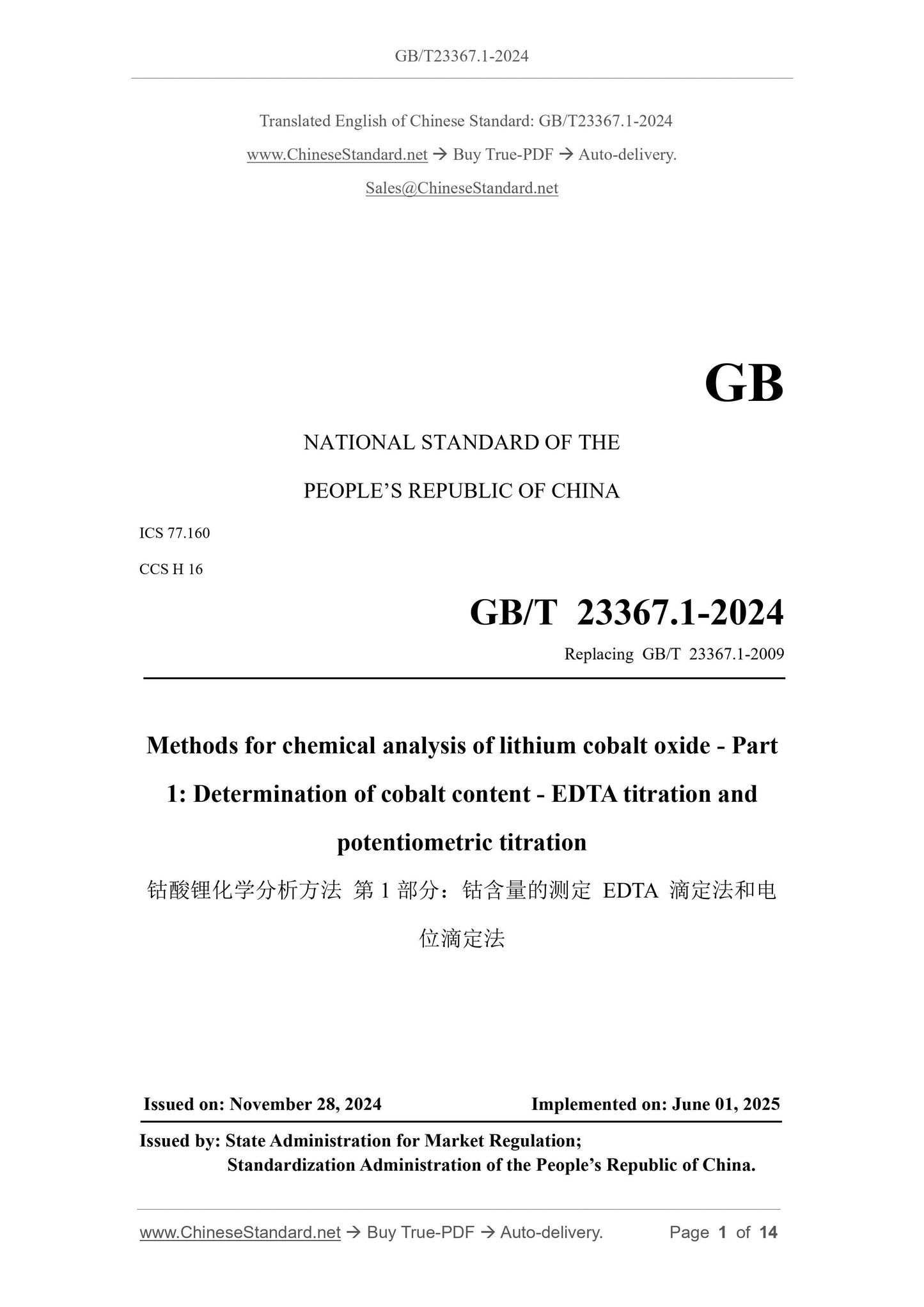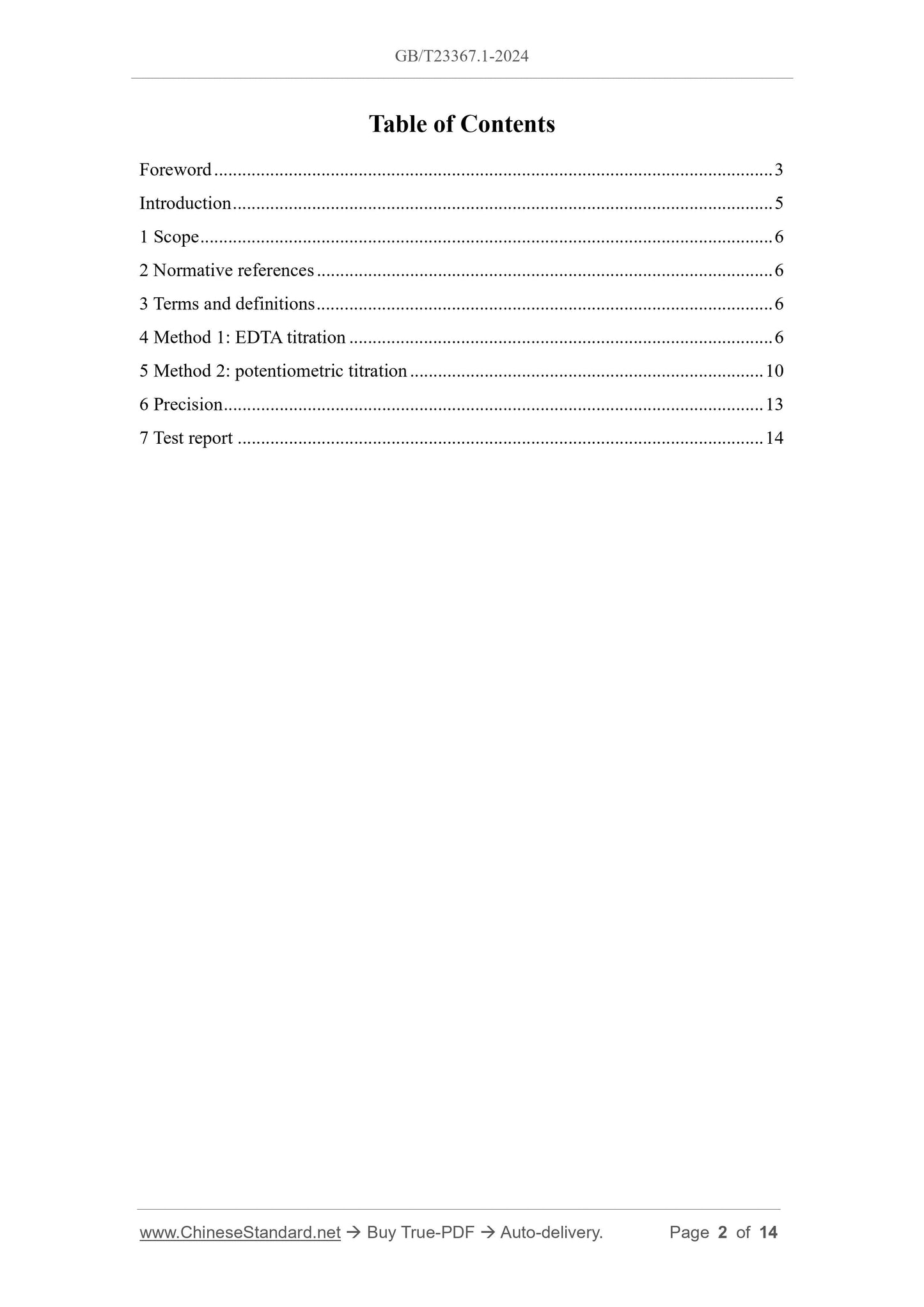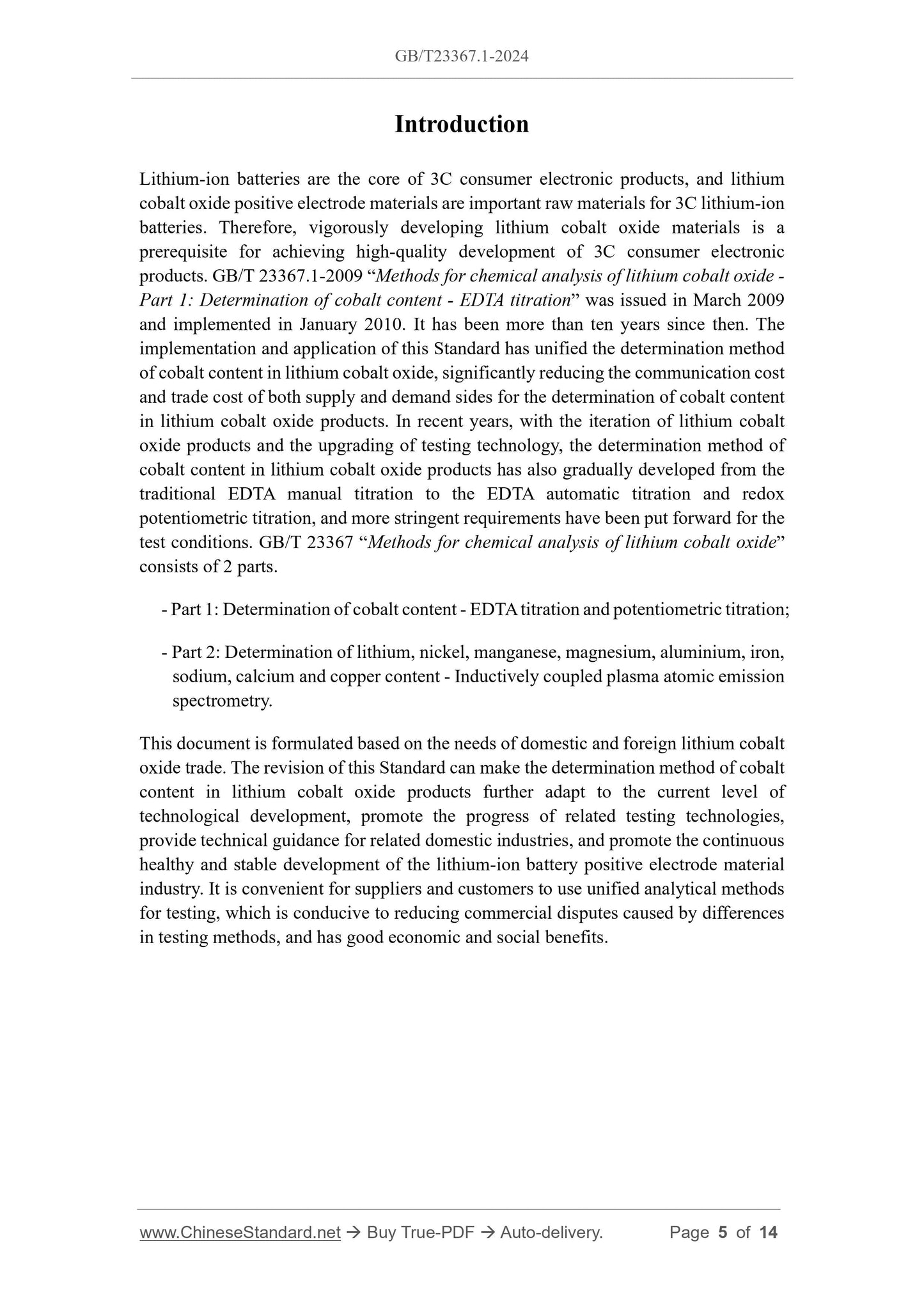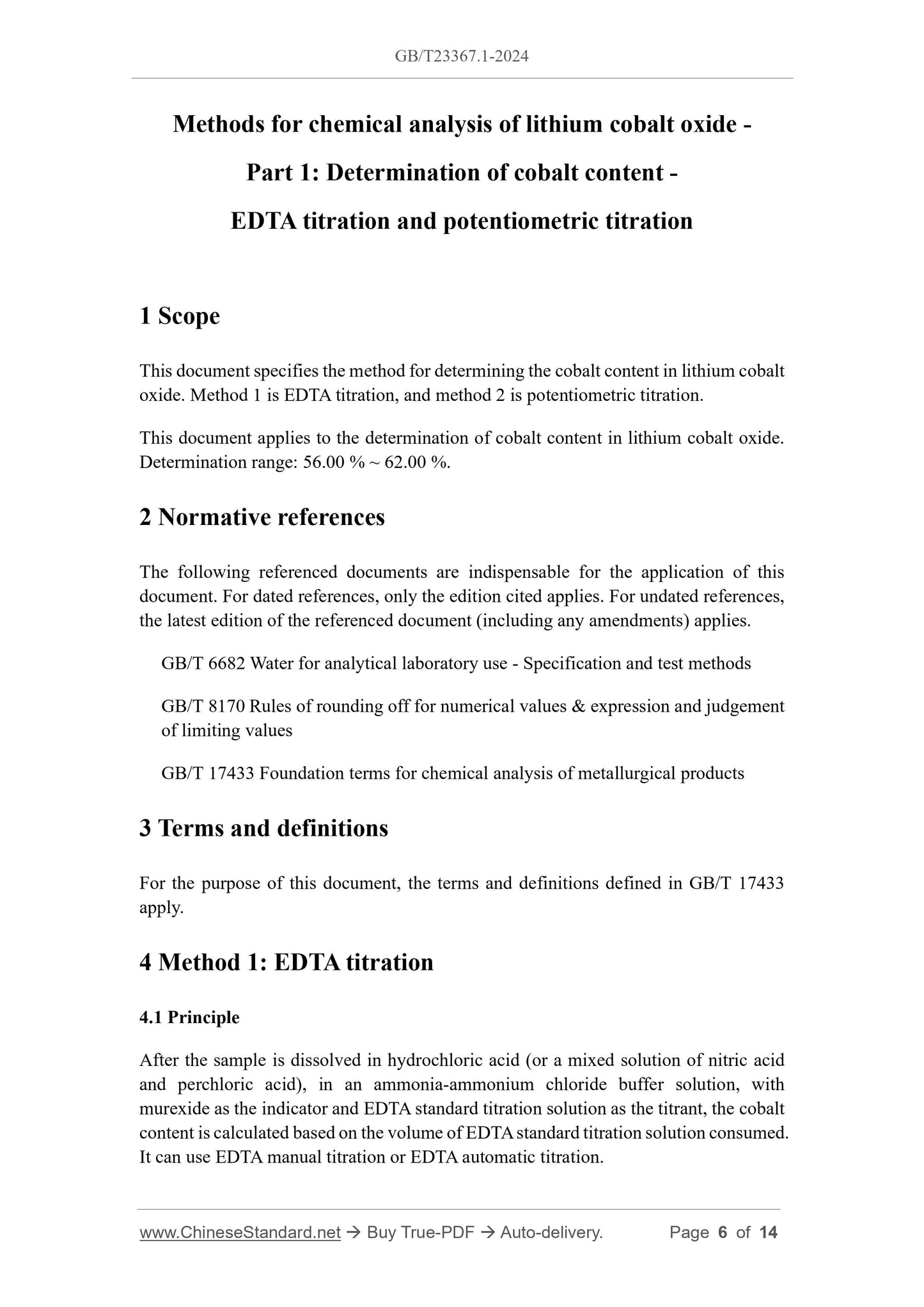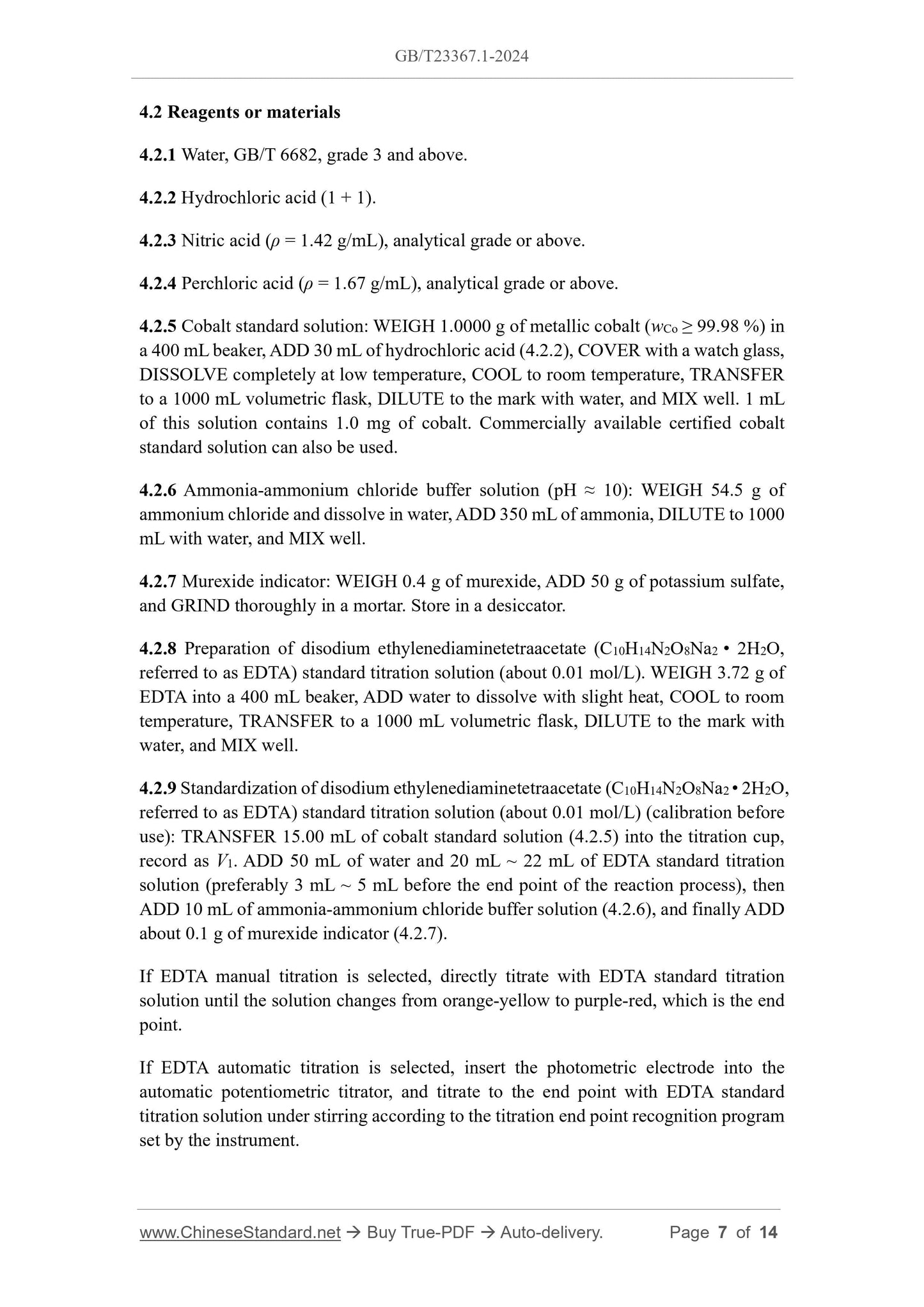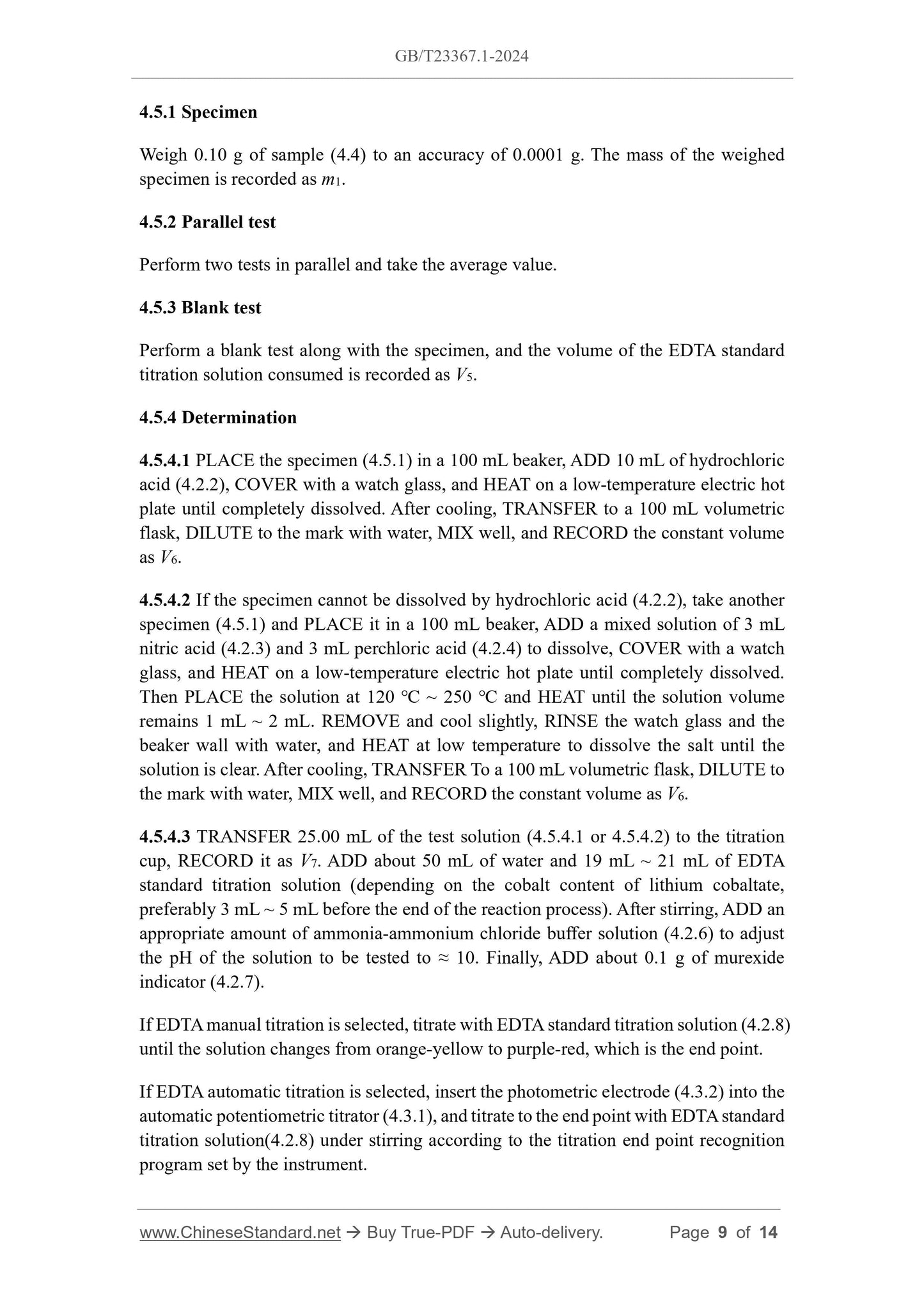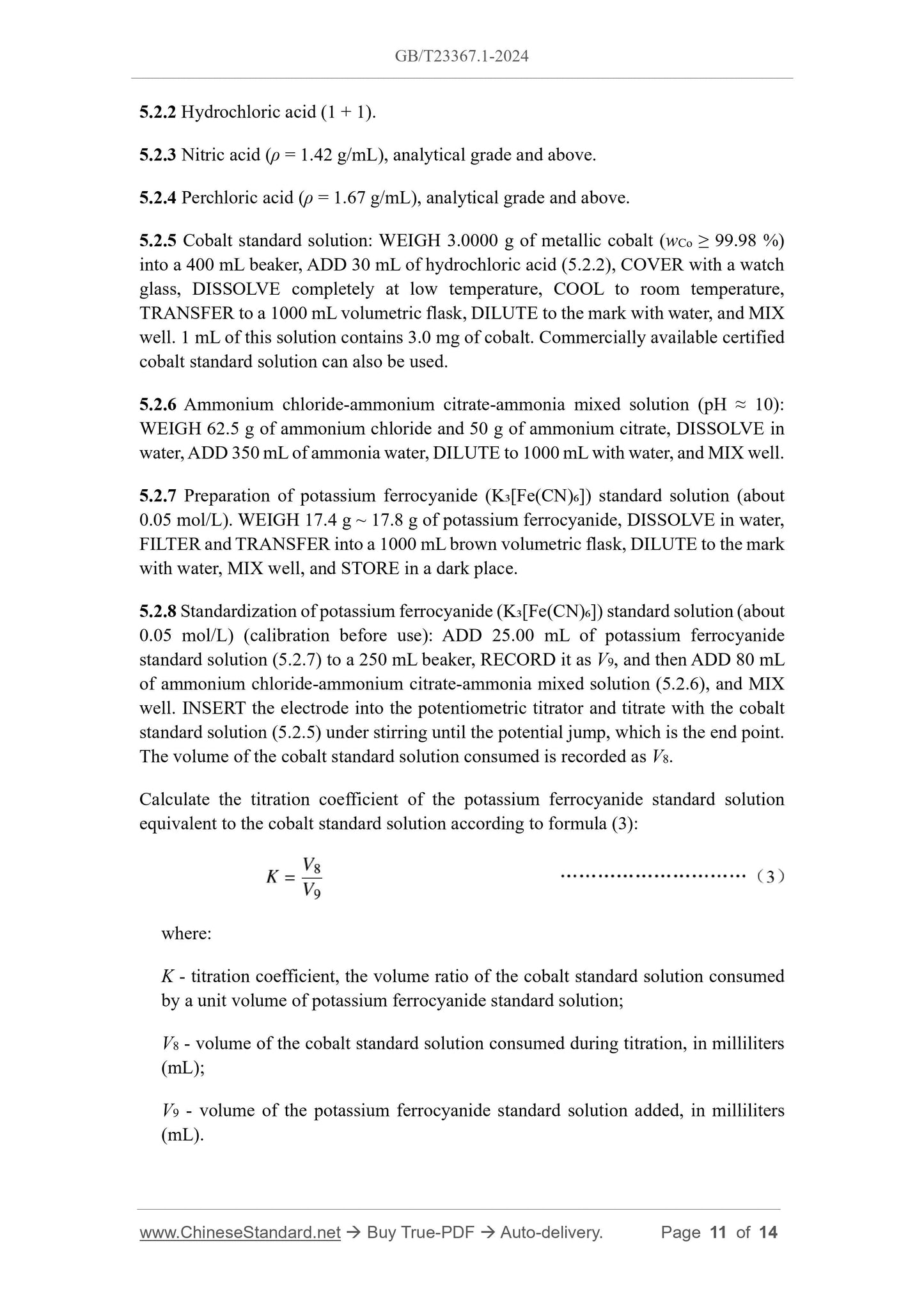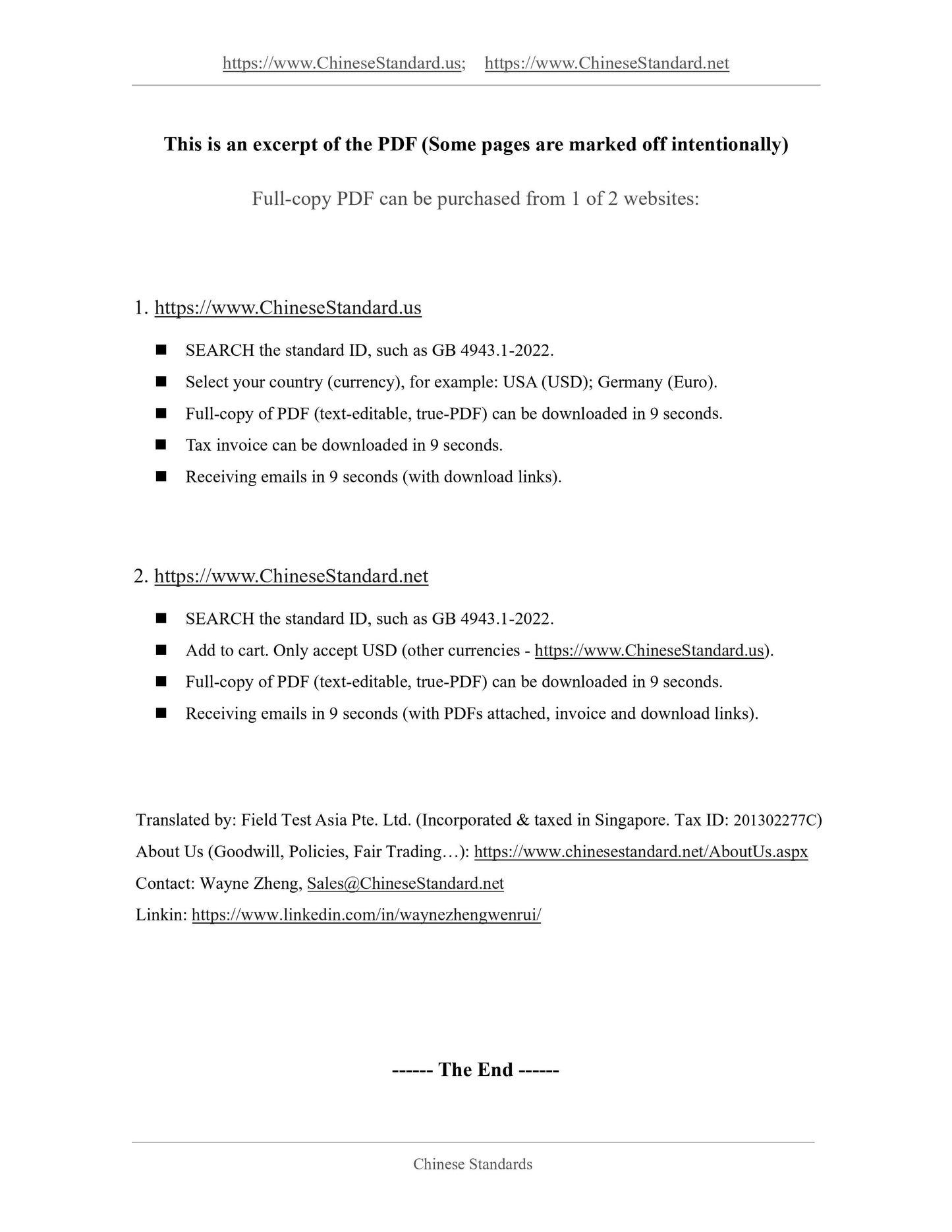1
/
of
9
www.ChineseStandard.us -- Field Test Asia Pte. Ltd.
GB/T 23367.1-2024 English PDF (GB/T23367.1-2024)
GB/T 23367.1-2024 English PDF (GB/T23367.1-2024)
Regular price
$215.00
Regular price
Sale price
$215.00
Unit price
/
per
Shipping calculated at checkout.
Couldn't load pickup availability
GB/T 23367.1-2024: Methods for chemical analysis of lithium cobalt oxide - Part 1: Determination of cobalt content - EDTA titration and potentiometric titration
Delivery: 9 seconds. Download (& Email) true-PDF + Invoice.
Get Quotation: Click GB/T 23367.1-2024 (Self-service in 1-minute)
Historical versions (Master-website): GB/T 23367.1-2024
Preview True-PDF (Reload/Scroll-down if blank)
GB/T 23367.1-2024
GB
NATIONAL STANDARD OF THE
PEOPLE’S REPUBLIC OF CHINA
ICS 77.160
CCS H 16
GB/T 23367.1-2024
Replacing GB/T 23367.1-2009
Methods for chemical analysis of lithium cobalt oxide - Part
1: Determination of cobalt content - EDTA titration and
potentiometric titration
ISSUED ON: NOVEMBER 28, 2024
IMPLEMENTED ON: JUNE 01, 2025
Issued by: State Administration for Market Regulation;
Standardization Administration of the People’s Republic of China.
Table of Contents
Foreword ... 3
Introduction ... 5
1 Scope ... 6
2 Normative references ... 6
3 Terms and definitions ... 6
4 Method 1: EDTA titration ... 6
5 Method 2: potentiometric titration ... 10
6 Precision ... 13
7 Test report ... 14
Introduction
Lithium-ion batteries are the core of 3C consumer electronic products, and lithium
cobalt oxide positive electrode materials are important raw materials for 3C lithium-ion
batteries. Therefore, vigorously developing lithium cobalt oxide materials is a
prerequisite for achieving high-quality development of 3C consumer electronic
products. GB/T 23367.1-2009 “Methods for chemical analysis of lithium cobalt oxide -
Part 1: Determination of cobalt content - EDTA titration” was issued in March 2009
and implemented in January 2010. It has been more than ten years since then. The
implementation and application of this Standard has unified the determination method
of cobalt content in lithium cobalt oxide, significantly reducing the communication cost
and trade cost of both supply and demand sides for the determination of cobalt content
in lithium cobalt oxide products. In recent years, with the iteration of lithium cobalt
oxide products and the upgrading of testing technology, the determination method of
cobalt content in lithium cobalt oxide products has also gradually developed from the
traditional EDTA manual titration to the EDTA automatic titration and redox
potentiometric titration, and more stringent requirements have been put forward for the
test conditions. GB/T 23367 “Methods for chemical analysis of lithium cobalt oxide”
consists of 2 parts.
- Part 1: Determination of cobalt content - EDTA titration and potentiometric titration;
- Part 2: Determination of lithium, nickel, manganese, magnesium, aluminium, iron,
sodium, calcium and copper content - Inductively coupled plasma atomic emission
spectrometry.
This document is formulated based on the needs of domestic and foreign lithium cobalt
oxide trade. The revision of this Standard can make the determination method of cobalt
content in lithium cobalt oxide products further adapt to the current level of
technological development, promote the progress of related testing technologies,
provide technical guidance for related domestic industries, and promote the continuous
healthy and stable development of the lithium-ion battery positive electrode material
industry. It is convenient for suppliers and customers to use unified analytical methods
for testing, which is conducive to reducing commercial disputes caused by differences
in testing methods, and has good economic and social benefits.
Methods for chemical analysis of lithium cobalt oxide -
Part 1: Determination of cobalt content -
EDTA titration and potentiometric titration
1 Scope
This document specifies the method for determining the cobalt content in lithium cobalt
oxide. Method 1 is EDTA titration, and method 2 is potentiometric titration.
This document applies to the determination of cobalt content in lithium cobalt oxide.
Determination range: 56.00 % ~ 62.00 %.
2 Normative references
The following referenced documents are indispensable for the application of this
document. For dated references, only the edition cited applies. For undated references,
the latest edition of the referenced document (including any amendments) applies.
GB/T 6682 Water for analytical laboratory use - Specification and test methods
GB/T 8170 Rules of rounding off for numerical values and expression and judgement
of limiting values
GB/T 17433 Foundation terms for chemical analysis of metallurgical products
3 Terms and definitions
For the purpose of this document, the terms and definitions defined in GB/T 17433
apply.
4 Method 1: EDTA titration
4.1 Principle
After the sample is dissolved in hydrochloric acid (or a mixed solution of nitric acid
and perchloric acid), in an ammonia-ammonium chloride buffer solution, with
murexide as the indicator and EDTA standard titration solution as the titrant, the cobalt
content is calculated based on the volume of EDTA standard titration solution consumed.
It can use EDTA manual titration or EDTA automatic titration.
4.2 Reagents or materials
4.2.1 Water, GB/T 6682, grade 3 and above.
4.2.2 Hydrochloric acid (1 + 1).
4.2.3 Nitric acid (ρ = 1.42 g/mL), analytical grade or above.
4.2.4 Perchloric acid (ρ = 1.67 g/mL), analytical grade or above.
4.2.5 Cobalt standard solution: WEIGH 1.0000 g of metallic cobalt (wCo ≥ 99.98 %) in
a 400 mL beaker, ADD 30 mL of hydrochloric acid (4.2.2), COVER with a watch glass,
DISSOLVE completely at low temperature, COOL to room temperature, TRANSFER
to a 1000 mL volumetric flask, DILUTE to the mark with water, and MIX well. 1 mL
of this solution contains 1.0 mg of cobalt. Commercially available certified cobalt
standard solution can also be used.
4.2.6 Ammonia-ammonium chloride buffer solution (pH ≈ 10): WEIGH 54.5 g of
ammonium chloride and dissolve in water, ADD 350 mL of ammonia, DILUTE to 1000
mL with water, and MIX well.
4.2.7 Murexide indicator: WEIGH 0.4 g of murexide, ADD 50 g of potassium sulfate,
and GRIND thoroughly in a mortar. Store in a desiccator.
4.2.8 Preparation of disodium ethylenediaminetetraacetate (C10H14N2O8Na2 • 2H2O,
referred to as EDTA) standard titration solution (about 0.01 mol/L). WEIGH 3.72 g of
EDTA into a 400 mL beaker, ADD water to dissolve with slight heat, COOL to room
temperature, TRANSFER to a 1000 mL volumetric flask, DILUTE to the mark with
water, and MIX well.
4.2.9 Standardization of disodium ethylenediaminetetraacetate (C10H14N2O8Na2 • 2H2O,
referred to as EDTA) standard titration solution (about 0.01 mol/L) (calibration before
use): TRANSFER 15.00 mL of cobalt standard solution (4.2.5) into the titration cup,
record as V1. ADD 50 mL of water and 20 mL ~ 22 mL of EDTA standard titration
solution (preferably 3 mL ~ 5 mL before the end point of the reaction process), then
ADD 10 mL of ammonia-ammonium chloride buffer solution (4.2.6), and finally ADD
about 0.1 g of murexide indicator (4.2.7).
If EDTA manual titration is selected, directly titrate with EDTA standard titration
solution until the solution changes from orange-yellow to purple-red, which is the end
point.
If EDTA automatic titration is selected, insert the photometric electrode into the
automatic potentiometric titrator, and titrate to the end point with EDTA standard
titration solution under stirring according to the titration end point recognition program
set by the instrument.
4.5.1 Specimen
Weigh 0.10 g of sample (4.4) to an accuracy of 0.0001 g. The mass of the weighed
specimen is recorded as m1.
4.5.2 Parallel test
Perform two tests in parallel and take the average value.
4.5.3 Blank test
Perform a blank test along with the specimen, and the volume of the EDTA standard
titration solution consumed is recorded as V5.
4.5.4 Determination
4.5.4.1 PLACE the specimen (4.5.1) in a 100 mL beaker, ADD 10 mL of hydrochloric
acid (4.2.2), COVER with a watch glass, and HEAT on a low-temperature electric hot
plate until completely dissolved. After cooling, TRANSFER to a 100 mL volumetric
flask, DILUTE to the mark with water, MIX well, and RECORD the constant volume
as V6.
4.5.4.2 If the specimen cannot be dissolved by hydrochloric acid (4.2.2), take another
specimen (4.5.1) and PLACE it in a 100 mL beaker, ADD a mixed solution of 3 mL
nitric acid (4.2.3) and 3 mL perchloric acid (4.2.4) to dissolve, COVER with a watch
glass, and HEAT on a low-temperature electric hot plate until completely dissolved.
Then PLACE the solution at 120 ℃ ~ 250 ℃ and HEAT until the solution volume
remains 1 mL ~ 2 mL. REMOVE and cool slightly, RINSE the watch glass and the
beaker wall with water, and HEAT at low temperature to dissolve the salt until the
solution is clear. After cooling, TRANSFER To a 100 mL volumetric flask, DILUTE to
the mark with water, MIX well, and RECORD the constant volume as V6.
4.5.4.3 TRANSFER 25.00 mL of the test solution (4.5.4.1 or 4.5.4.2) to the titration
cup, RECORD it as V7. ADD about 50 mL of water and 19 mL ~ 21 mL of EDTA
standard titration solution (depending on the cobalt content of lithium cobaltate,
preferably 3 mL ~ 5 mL before the end of the reaction process). After stirring, ADD an
appropriate amount of ammonia-ammonium chloride buffer solution (4.2.6) to adjust
the pH of the solution to be tested to ≈ 10. Finally, ADD about 0.1 g of murexide
indicator (4.2.7).
If EDTA manual titration is selected, titrate with EDTA standard titration solution (4.2.8)
until the solution changes from orange-yellow to purple-red, which is the end point.
If EDTA automatic titration is selected, insert the photometric electrode (4.3.2) into the
automatic potentiometric titrator (4.3.1), and titrate to the end point with EDTA standard
titration solution(4.2.8) under stirring according to the titration end point recognition
program set by the instrument.
5.2.2 Hydrochloric acid (1 + 1).
5.2.3 Nitric acid (ρ = 1.42 g/mL), analytical grade and above.
5.2.4 Perchloric acid (ρ = 1.67 g/mL), analytical grade and above.
5.2.5 Cobalt standard solution: WEIGH 3.0000 g of metallic cobalt (wCo ≥ 99.98 %)
into a 400 mL beaker, ADD 30 mL of hydrochloric acid (5.2.2), COVER with a watch
glass, DISSOLVE completely at low temperature, COOL to room temperature,
TRANSFER to a 1000 mL volumetric flask, DILUTE to the mark with water, and MIX
well. 1 mL of this solution contains 3.0 mg of cobalt. Commercially available certified
cobalt standard solution can also be used.
5.2.6 Ammonium chloride-ammonium citrate-ammonia mixed solution (pH ≈ 10):
WEIGH 62.5 g of ammonium chloride and 50 g of ammonium citrate, DISSOLVE in
water, ADD 350 mL of ammonia water, DILUTE to 1000 mL with water, and MIX well.
5.2.7 Preparation of potassium ferrocyanide (K₃[Fe(CN)₆]) standard solution (about
0.05 mol/L). WEIGH 17.4 g ~ 17.8 g of potassium ferrocyanide, DISSOLVE in water,
FILTER and TRANSFER into a 1000 mL brown volumetric flask, DILUTE to the mark
with water, MIX well, and STORE in a dark place.
5.2.8 Standardization of potassium ferrocyanide (K₃[Fe(CN)₆]) standard solution (about
0.05 mol/L) (calibration before use): ADD 25.00 mL of potassium ferrocyanide
standard solution (5.2.7) to a 250 mL beaker, RECORD it as V9, and then ADD 80 mL
of ammonium chloride-ammonium citrate-ammonia mixed solution (5.2.6), and MIX
well. INSERT the electrode into the potentiometric titrator and titrate with the cobalt
standard solution (5.2.5) under stirring until the potential jump, which is the end point.
The volume of the cobalt standard solution consumed is recorded as V8.
Calculate the titration coefficient of the potassium ferrocyanide standard solution
equivalent to the cobalt standard solution according to formula (3):
where:
K - titration coefficient, the volume ratio of the cobalt standard solution consumed
by a unit volume of potassium ferrocyanide standard solution;
V8 - volume of the cobalt standard solution consumed during titration, in milliliters
(mL);
V9 - volume of the potassium ferrocyanide standard solution added, in milliliters
(mL).
Perform three parallel calibrations. The range of the volume of the cobalt standard
solution consumed shall not be greater than 0.05 mL. Take the average value. Otherwise,
recalibrate. The calculation result is retained to four decimal places, and the rounding
off of numerical values is carried out in accordance with the provisions of GB/T 8170.
5.3 Instruments and equipment
5.3.1 Automatic potentiometric titrator with stirring device.
5.3.2 Redox electrodes matching the instrument.
5.4 Samples
5.4.1 The sample particle size shall not be greater than 100 μm.
5.4.2 Before analysis, the sample shall be dried at 110 ℃ ± 5 ℃ for 2 h and placed in a
desiccator to cool to room temperature.
5.5 Test steps
5.5.1 Specimen
Weigh 1.00 g of sample (5.4) to an accuracy of 0.0001 g. The mass of the weighed
specimen is recorded as m2.
5.5.2 Parallel test
Perform two tests in parallel and take the average value.
5.5.3 Determination
5.5.3.1 PLACE the specimen (5.5.1) in a 100 mL beaker, ADD a small amount of water
to moisten it, slowly ADD 20 mL of hydrochloric acid (5.2.2), COVER with a watch
glass, and HEAT at low temperature until the specimen is completely dissolved. After
cooling, TRANSFER to a 250 mL volumetric flask, DILUTE to the mark with water,
SHAKE well, and RECORD the constant volume as V12.
5.5.3.2 If the specimen cannot be dissolved by hydrochloric acid (5.2.2), TAKE another
specimen (5.5.1) and place it in a 100 mL beaker, ADD a mixed solution of 5 mL nitric
acid (5.2.3) and 5 mL perchloric acid (5.2.4) to dissolve, COVER with a watch glass,
and HEAT at low temperature until the specimen is completely dissolved. Then PLACE
the solution at 120 ℃ ~ 250 ℃, HEAT to drive out the acid until the solution volume
is about 1 mL ~ 2 mL. REMOVE and cool slightly, RINSE the watch glass and the
beaker wall with water, and HEAT at low temperature to dissolve the salts until the
solution is clear. After cooling, TRANSFER to a 250 mL volumetric flask, DILUTE to
the mark with water, SHAKE well, and RECORD the constant volume as V12.
GB/T 23367.1-2024
GB
NATIONAL STANDARD OF THE
PEOPLE’S REPUBLIC OF CHINA
ICS 77.160
CCS H 16
GB/T 23367.1-2024
Replacing GB/T 23367.1-2009
Methods for chemical analysis of lithium cobalt oxide - Part
1: Determination of cobalt content - EDTA titration an...
Delivery: 9 seconds. Download (& Email) true-PDF + Invoice.
Get Quotation: Click GB/T 23367.1-2024 (Self-service in 1-minute)
Historical versions (Master-website): GB/T 23367.1-2024
Preview True-PDF (Reload/Scroll-down if blank)
GB/T 23367.1-2024
GB
NATIONAL STANDARD OF THE
PEOPLE’S REPUBLIC OF CHINA
ICS 77.160
CCS H 16
GB/T 23367.1-2024
Replacing GB/T 23367.1-2009
Methods for chemical analysis of lithium cobalt oxide - Part
1: Determination of cobalt content - EDTA titration and
potentiometric titration
ISSUED ON: NOVEMBER 28, 2024
IMPLEMENTED ON: JUNE 01, 2025
Issued by: State Administration for Market Regulation;
Standardization Administration of the People’s Republic of China.
Table of Contents
Foreword ... 3
Introduction ... 5
1 Scope ... 6
2 Normative references ... 6
3 Terms and definitions ... 6
4 Method 1: EDTA titration ... 6
5 Method 2: potentiometric titration ... 10
6 Precision ... 13
7 Test report ... 14
Introduction
Lithium-ion batteries are the core of 3C consumer electronic products, and lithium
cobalt oxide positive electrode materials are important raw materials for 3C lithium-ion
batteries. Therefore, vigorously developing lithium cobalt oxide materials is a
prerequisite for achieving high-quality development of 3C consumer electronic
products. GB/T 23367.1-2009 “Methods for chemical analysis of lithium cobalt oxide -
Part 1: Determination of cobalt content - EDTA titration” was issued in March 2009
and implemented in January 2010. It has been more than ten years since then. The
implementation and application of this Standard has unified the determination method
of cobalt content in lithium cobalt oxide, significantly reducing the communication cost
and trade cost of both supply and demand sides for the determination of cobalt content
in lithium cobalt oxide products. In recent years, with the iteration of lithium cobalt
oxide products and the upgrading of testing technology, the determination method of
cobalt content in lithium cobalt oxide products has also gradually developed from the
traditional EDTA manual titration to the EDTA automatic titration and redox
potentiometric titration, and more stringent requirements have been put forward for the
test conditions. GB/T 23367 “Methods for chemical analysis of lithium cobalt oxide”
consists of 2 parts.
- Part 1: Determination of cobalt content - EDTA titration and potentiometric titration;
- Part 2: Determination of lithium, nickel, manganese, magnesium, aluminium, iron,
sodium, calcium and copper content - Inductively coupled plasma atomic emission
spectrometry.
This document is formulated based on the needs of domestic and foreign lithium cobalt
oxide trade. The revision of this Standard can make the determination method of cobalt
content in lithium cobalt oxide products further adapt to the current level of
technological development, promote the progress of related testing technologies,
provide technical guidance for related domestic industries, and promote the continuous
healthy and stable development of the lithium-ion battery positive electrode material
industry. It is convenient for suppliers and customers to use unified analytical methods
for testing, which is conducive to reducing commercial disputes caused by differences
in testing methods, and has good economic and social benefits.
Methods for chemical analysis of lithium cobalt oxide -
Part 1: Determination of cobalt content -
EDTA titration and potentiometric titration
1 Scope
This document specifies the method for determining the cobalt content in lithium cobalt
oxide. Method 1 is EDTA titration, and method 2 is potentiometric titration.
This document applies to the determination of cobalt content in lithium cobalt oxide.
Determination range: 56.00 % ~ 62.00 %.
2 Normative references
The following referenced documents are indispensable for the application of this
document. For dated references, only the edition cited applies. For undated references,
the latest edition of the referenced document (including any amendments) applies.
GB/T 6682 Water for analytical laboratory use - Specification and test methods
GB/T 8170 Rules of rounding off for numerical values and expression and judgement
of limiting values
GB/T 17433 Foundation terms for chemical analysis of metallurgical products
3 Terms and definitions
For the purpose of this document, the terms and definitions defined in GB/T 17433
apply.
4 Method 1: EDTA titration
4.1 Principle
After the sample is dissolved in hydrochloric acid (or a mixed solution of nitric acid
and perchloric acid), in an ammonia-ammonium chloride buffer solution, with
murexide as the indicator and EDTA standard titration solution as the titrant, the cobalt
content is calculated based on the volume of EDTA standard titration solution consumed.
It can use EDTA manual titration or EDTA automatic titration.
4.2 Reagents or materials
4.2.1 Water, GB/T 6682, grade 3 and above.
4.2.2 Hydrochloric acid (1 + 1).
4.2.3 Nitric acid (ρ = 1.42 g/mL), analytical grade or above.
4.2.4 Perchloric acid (ρ = 1.67 g/mL), analytical grade or above.
4.2.5 Cobalt standard solution: WEIGH 1.0000 g of metallic cobalt (wCo ≥ 99.98 %) in
a 400 mL beaker, ADD 30 mL of hydrochloric acid (4.2.2), COVER with a watch glass,
DISSOLVE completely at low temperature, COOL to room temperature, TRANSFER
to a 1000 mL volumetric flask, DILUTE to the mark with water, and MIX well. 1 mL
of this solution contains 1.0 mg of cobalt. Commercially available certified cobalt
standard solution can also be used.
4.2.6 Ammonia-ammonium chloride buffer solution (pH ≈ 10): WEIGH 54.5 g of
ammonium chloride and dissolve in water, ADD 350 mL of ammonia, DILUTE to 1000
mL with water, and MIX well.
4.2.7 Murexide indicator: WEIGH 0.4 g of murexide, ADD 50 g of potassium sulfate,
and GRIND thoroughly in a mortar. Store in a desiccator.
4.2.8 Preparation of disodium ethylenediaminetetraacetate (C10H14N2O8Na2 • 2H2O,
referred to as EDTA) standard titration solution (about 0.01 mol/L). WEIGH 3.72 g of
EDTA into a 400 mL beaker, ADD water to dissolve with slight heat, COOL to room
temperature, TRANSFER to a 1000 mL volumetric flask, DILUTE to the mark with
water, and MIX well.
4.2.9 Standardization of disodium ethylenediaminetetraacetate (C10H14N2O8Na2 • 2H2O,
referred to as EDTA) standard titration solution (about 0.01 mol/L) (calibration before
use): TRANSFER 15.00 mL of cobalt standard solution (4.2.5) into the titration cup,
record as V1. ADD 50 mL of water and 20 mL ~ 22 mL of EDTA standard titration
solution (preferably 3 mL ~ 5 mL before the end point of the reaction process), then
ADD 10 mL of ammonia-ammonium chloride buffer solution (4.2.6), and finally ADD
about 0.1 g of murexide indicator (4.2.7).
If EDTA manual titration is selected, directly titrate with EDTA standard titration
solution until the solution changes from orange-yellow to purple-red, which is the end
point.
If EDTA automatic titration is selected, insert the photometric electrode into the
automatic potentiometric titrator, and titrate to the end point with EDTA standard
titration solution under stirring according to the titration end point recognition program
set by the instrument.
4.5.1 Specimen
Weigh 0.10 g of sample (4.4) to an accuracy of 0.0001 g. The mass of the weighed
specimen is recorded as m1.
4.5.2 Parallel test
Perform two tests in parallel and take the average value.
4.5.3 Blank test
Perform a blank test along with the specimen, and the volume of the EDTA standard
titration solution consumed is recorded as V5.
4.5.4 Determination
4.5.4.1 PLACE the specimen (4.5.1) in a 100 mL beaker, ADD 10 mL of hydrochloric
acid (4.2.2), COVER with a watch glass, and HEAT on a low-temperature electric hot
plate until completely dissolved. After cooling, TRANSFER to a 100 mL volumetric
flask, DILUTE to the mark with water, MIX well, and RECORD the constant volume
as V6.
4.5.4.2 If the specimen cannot be dissolved by hydrochloric acid (4.2.2), take another
specimen (4.5.1) and PLACE it in a 100 mL beaker, ADD a mixed solution of 3 mL
nitric acid (4.2.3) and 3 mL perchloric acid (4.2.4) to dissolve, COVER with a watch
glass, and HEAT on a low-temperature electric hot plate until completely dissolved.
Then PLACE the solution at 120 ℃ ~ 250 ℃ and HEAT until the solution volume
remains 1 mL ~ 2 mL. REMOVE and cool slightly, RINSE the watch glass and the
beaker wall with water, and HEAT at low temperature to dissolve the salt until the
solution is clear. After cooling, TRANSFER To a 100 mL volumetric flask, DILUTE to
the mark with water, MIX well, and RECORD the constant volume as V6.
4.5.4.3 TRANSFER 25.00 mL of the test solution (4.5.4.1 or 4.5.4.2) to the titration
cup, RECORD it as V7. ADD about 50 mL of water and 19 mL ~ 21 mL of EDTA
standard titration solution (depending on the cobalt content of lithium cobaltate,
preferably 3 mL ~ 5 mL before the end of the reaction process). After stirring, ADD an
appropriate amount of ammonia-ammonium chloride buffer solution (4.2.6) to adjust
the pH of the solution to be tested to ≈ 10. Finally, ADD about 0.1 g of murexide
indicator (4.2.7).
If EDTA manual titration is selected, titrate with EDTA standard titration solution (4.2.8)
until the solution changes from orange-yellow to purple-red, which is the end point.
If EDTA automatic titration is selected, insert the photometric electrode (4.3.2) into the
automatic potentiometric titrator (4.3.1), and titrate to the end point with EDTA standard
titration solution(4.2.8) under stirring according to the titration end point recognition
program set by the instrument.
5.2.2 Hydrochloric acid (1 + 1).
5.2.3 Nitric acid (ρ = 1.42 g/mL), analytical grade and above.
5.2.4 Perchloric acid (ρ = 1.67 g/mL), analytical grade and above.
5.2.5 Cobalt standard solution: WEIGH 3.0000 g of metallic cobalt (wCo ≥ 99.98 %)
into a 400 mL beaker, ADD 30 mL of hydrochloric acid (5.2.2), COVER with a watch
glass, DISSOLVE completely at low temperature, COOL to room temperature,
TRANSFER to a 1000 mL volumetric flask, DILUTE to the mark with water, and MIX
well. 1 mL of this solution contains 3.0 mg of cobalt. Commercially available certified
cobalt standard solution can also be used.
5.2.6 Ammonium chloride-ammonium citrate-ammonia mixed solution (pH ≈ 10):
WEIGH 62.5 g of ammonium chloride and 50 g of ammonium citrate, DISSOLVE in
water, ADD 350 mL of ammonia water, DILUTE to 1000 mL with water, and MIX well.
5.2.7 Preparation of potassium ferrocyanide (K₃[Fe(CN)₆]) standard solution (about
0.05 mol/L). WEIGH 17.4 g ~ 17.8 g of potassium ferrocyanide, DISSOLVE in water,
FILTER and TRANSFER into a 1000 mL brown volumetric flask, DILUTE to the mark
with water, MIX well, and STORE in a dark place.
5.2.8 Standardization of potassium ferrocyanide (K₃[Fe(CN)₆]) standard solution (about
0.05 mol/L) (calibration before use): ADD 25.00 mL of potassium ferrocyanide
standard solution (5.2.7) to a 250 mL beaker, RECORD it as V9, and then ADD 80 mL
of ammonium chloride-ammonium citrate-ammonia mixed solution (5.2.6), and MIX
well. INSERT the electrode into the potentiometric titrator and titrate with the cobalt
standard solution (5.2.5) under stirring until the potential jump, which is the end point.
The volume of the cobalt standard solution consumed is recorded as V8.
Calculate the titration coefficient of the potassium ferrocyanide standard solution
equivalent to the cobalt standard solution according to formula (3):
where:
K - titration coefficient, the volume ratio of the cobalt standard solution consumed
by a unit volume of potassium ferrocyanide standard solution;
V8 - volume of the cobalt standard solution consumed during titration, in milliliters
(mL);
V9 - volume of the potassium ferrocyanide standard solution added, in milliliters
(mL).
Perform three parallel calibrations. The range of the volume of the cobalt standard
solution consumed shall not be greater than 0.05 mL. Take the average value. Otherwise,
recalibrate. The calculation result is retained to four decimal places, and the rounding
off of numerical values is carried out in accordance with the provisions of GB/T 8170.
5.3 Instruments and equipment
5.3.1 Automatic potentiometric titrator with stirring device.
5.3.2 Redox electrodes matching the instrument.
5.4 Samples
5.4.1 The sample particle size shall not be greater than 100 μm.
5.4.2 Before analysis, the sample shall be dried at 110 ℃ ± 5 ℃ for 2 h and placed in a
desiccator to cool to room temperature.
5.5 Test steps
5.5.1 Specimen
Weigh 1.00 g of sample (5.4) to an accuracy of 0.0001 g. The mass of the weighed
specimen is recorded as m2.
5.5.2 Parallel test
Perform two tests in parallel and take the average value.
5.5.3 Determination
5.5.3.1 PLACE the specimen (5.5.1) in a 100 mL beaker, ADD a small amount of water
to moisten it, slowly ADD 20 mL of hydrochloric acid (5.2.2), COVER with a watch
glass, and HEAT at low temperature until the specimen is completely dissolved. After
cooling, TRANSFER to a 250 mL volumetric flask, DILUTE to the mark with water,
SHAKE well, and RECORD the constant volume as V12.
5.5.3.2 If the specimen cannot be dissolved by hydrochloric acid (5.2.2), TAKE another
specimen (5.5.1) and place it in a 100 mL beaker, ADD a mixed solution of 5 mL nitric
acid (5.2.3) and 5 mL perchloric acid (5.2.4) to dissolve, COVER with a watch glass,
and HEAT at low temperature until the specimen is completely dissolved. Then PLACE
the solution at 120 ℃ ~ 250 ℃, HEAT to drive out the acid until the solution volume
is about 1 mL ~ 2 mL. REMOVE and cool slightly, RINSE the watch glass and the
beaker wall with water, and HEAT at low temperature to dissolve the salts until the
solution is clear. After cooling, TRANSFER to a 250 mL volumetric flask, DILUTE to
the mark with water, SHAKE well, and RECORD the constant volume as V12.
GB/T 23367.1-2024
GB
NATIONAL STANDARD OF THE
PEOPLE’S REPUBLIC OF CHINA
ICS 77.160
CCS H 16
GB/T 23367.1-2024
Replacing GB/T 23367.1-2009
Methods for chemical analysis of lithium cobalt oxide - Part
1: Determination of cobalt content - EDTA titration an...
Share
